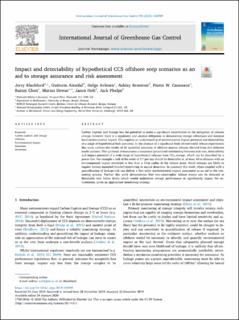Impact and detectability of hypothetical CCS offshore seep scenarios as an aid to storage assurance and risk assessment
Blackford, Jerry; Alendal, Guttorm; Avlesen, Helge; Brereton, Ashley; Cazenave, Pierre W; Chen, Baixin; Dewar, Marius; Holt, Jason; Phelps, Jack
Journal article, Peer reviewed
Published version

Åpne
Permanent lenke
https://hdl.handle.net/11250/2720580Utgivelsesdato
2020Metadata
Vis full innførselSamlinger
- Department of Mathematics [939]
- Registrations from Cristin [9791]
Originalversjon
10.1016/j.ijggc.2019.102949Sammendrag
Carbon Capture and Storage has the potential to make a significant contribution to the mitigation of climate change, however there is a regulatory and societal obligation to demonstrate storage robustness and minimal local environmental impact. This requires an understanding of environmental impact potential and detectability of a range of hypothetical leak scenarios. In the absence of a significant body of real-world release experiments this study collates the results of 86 modelled scenarios of offshore marine releases derived from five different model systems. This synthesis demonstrates a consistent generalised relationship between leak rate, detectability and impact potential of a wide range of hypothetical releases from CO2 storage, which can be described by a power law. For example a leak of the order of 1 T per day should be detectable at, at least, 60 m distance with an environmental impact restricted to less than a 15 m radius of the release point. Small releases are likely to require bottom mounted (lander) monitoring to ensure detection. In summary this work, when coupled with a quantification of leakage risk can deliver a first order environmental impact assessment as an aid to the consenting process. Further this work demonstrates that non-catastrophic release events can be detected at thresholds well below levels which would undermine storage performance or significantly impact the environment, given an appropriate monitoring strategy.
